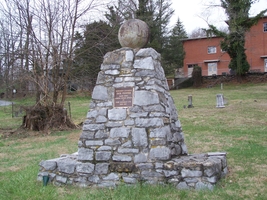 | Back to e-WV
| Back to e-WV
 The West Virginia Encyclopedia
The West Virginia Encyclopedia
 | Back to e-WV
| Back to e-WV
 The West Virginia Encyclopedia
The West Virginia Encyclopedia

On May 29, 1778, Dick Pointer, a black slave, helped to save about 60 settlers in the Greenbrier Valley. Warned that a band of Shawnee Indians had left the Ohio Valley with the intent of attacking the Greenbrier settlements, the settlers with Pointer among them decided to shelter at Fort Donnally near Lewisburg. The Indians attacked the fort the next day.
On the morning of the attack Pointer and a Philip Hammond, of European descent, were the first to hear the alarm, given by settler William Hughart as he rushed to close the fort door on the attacking Indians. The Indians began hacking at the door with tomahawks. Their effort failed due to the quick thinking of Pointer and Hammond, who rolled a hogshead of water behind the door. Pointer also managed to fire at the invaders, thus alerting the sleeping inhabitants.
The surprised settlers fought the Indians as they jumped from their beds. At dark, the Indians retreated and the attack was over. For his bravery Pointer was granted a life lease to a piece of land, where he lived until his death at about age 89 in 1827. In 1795, the thankful friends of Dick Pointer petitioned the Virginia Assembly for his freedom but were refused, although he was purchased and freed in 1801. In 1976, a stone was dedicated in Lewisburg to honor Dick Pointer’s heroism. His musket is now in the State Museum in Charleston.
Written by Cathy Hershberger Miller
Rice, Otis K. & Stephen W. Brown. West Virginia: A History. Lexington: University Press of Kentucky, 1993.
Bice, David A. A Panorama of West Virginia II. South Charleston: Jalamap, 1985.
Lewis, Virgil A. History of West Virginia in Two Parts. Philadelphia: Hubbard Brothers, 1889.